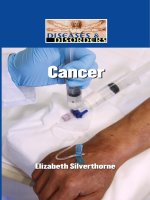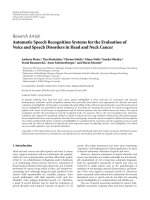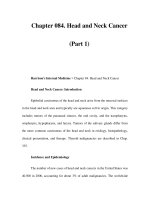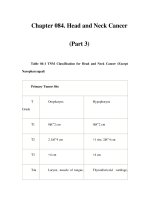DIAGNOSIS AND MANAGEMENT OF HEAD AND NECK CANCER pptx
Bạn đang xem bản rút gọn của tài liệu. Xem và tải ngay bản đầy đủ của tài liệu tại đây (217.23 KB, 16 trang )
SIGN
Scottish Intercollegiate Guidelines Network
90
Diagnosis and management
of head and neck cancer
Quick Reference Guide
October 2006
COPIES OF ALL SIGN GUIDELINES ARE AVAILABLE
ONLINE AT WWW.SIGN.AC.UK
ALL HEAD AND NECK CANCERS
REDUCING RISK
The risk of having head and neck cancer can be reduced
by:
B
B
not smoking or chewing tobacco
C
increasing the intake of fruit and vegetables
(specifically tomatoes), olive oil and fish oils
C
reducing the intake of red meat, fried food and fat.
limiting alcohol consumption, in line with government
guidelines
PRESENTATION AND SCREENING
All healthcare practitioners, including dental and medical
practitioners, should be aware of the presenting features of
head and neck cancer, and the local referral pathways for
suspected cancers.
Dental practitioners should include a full examination of
the oral mucosa as part of routine dental check up.
B
Leaflets about signs, symptoms and risks of head and neck
cancer should be available in primary care.
REFERRAL
B
Rapid access or “one stop” clinics should be available for
patients who fulfil appropriate referral criteria.
Patients should be seen within two weeks of urgent
referral.
DIAGNOSIS AND STAGING
D Fine needle aspiration cytology should be used in the
investigation of head and neck masses.
D All patients with head and neck cancer should have direct
pharyngolaryngoscopy and chest X-ray with symptomdirected endoscopy where indicated.
D
CT or MRI of the primary tumour site should be
performed to help define the T stage of the tumour.
MRI should be used to stage oropharyngeal and oral
tumours.
D MRI should be used in assessing:
laryngeal cartilage invasion
tumour involvement of the skull base, orbit, cervical
spine or neurovascular structures (most suprahyoid
tumours).
1
ALL HEAD AND NECK CANCERS
DIAGNOSIS AND STAGING (cont)
D CT or MRI from skull-base to sternoclavicular joints
should be performed in all patients at the time of imaging
the primary tumour to stage the neck for nodal metastatic
disease.
B
Where the nodal staging on CT or MRI is equivocal,
USFNA and/or FDG-PET increase the accuracy of nodal
staging.
D All patients with head and neck cancer should undergo
CT of the thorax.
C FDG-PET should be performed as the next investigation of
choice in patients presenting with:
cervical lymph node metastases, where CT or MRI does
not demonstrate an obvious primary tumour.
suspected recurrent head and neck cancer, where
CT/MRI does not demonstrate a clear cut recurrence.
HISTOPATHOLOGY REPORTING
C Histopathology reporting of specimens from the primary
site of head and neck cancer should include:
tumour site
tumour grade
maximum tumour dimension
maximum depth of invasion
margin involvement by invasive and/or severe dysplasia
pattern of infiltration
perineural involvement
D
tumour type
lymphatic/vascular permeation.
C Histopathology reporting of specimens from areas of
metastatic disease in patients with head and neck cancer
should include:
number of involved nodes
level of involved nodes
extracapsular spread of tumour
type of nodal dissection
size of largest tumour mass.
2
ALL HEAD AND NECK CANCERS
DEFINITIONS
Laryngeal cancer includes tumours of the:
supraglottis
glottis
subglottis.
Hypopharyngeal cancer includes tumours of the:
postcricoid area
pyriform sinus
posterior pharyngeal wall.
Oropharyngeal cancer includes tumours of the:
base of tongue
tonsil
soft palate.
Oral cavity cancer includes tumours of the:
buccal mucosa
retromolar triangle
alveolus
hard palate
anterior two-thirds of tongue
floor of mouth
mucosal surface of the lip.
DIAGRAM OF THE HEAD AND NECK
Oral cavity
Oropharynx
Larynx
Hypopharynx
3
ALL HEAD AND NECK CANCERS
DIAGRAM OF THE LYMPH NODES LEVELS IN THE NECK
I
II
III
VI
IV
V
NECK DISSECTION TECHNIQUES
Comprehensive neck dissection
Radical neck dissection
All ipsilateral lymph nodes from
level I-V are removed along
with the spinal accessory nerve,
internal jugular vein and sternocleidomastoid muscle.
-
section
As for radical neck dissection
with preservation of one or more
non-lymphatic structures. This
is sometimes referred to as a
“functional” neck dissection.
Selective neck dissection
One or more of the lymphatic groups normally removed in the
radical neck dissection is preserved. The lymph node groups
removed are based on patterns of metastases which are predictable for each site of the disease.
Extended neck dissection
Additional lymph node groups or non-lymphatic structures are
removed.
4
LARYNGEAL CANCER
Early glottic cancer
D Patients with early glottic cancer may be treated either by
B
D
external beam radiotherapy or conservation surgery:
external beam radiotherapy in short fractionation
regimens with fraction size >2Gy (eg 53-55Gy in 20
fractions over 28 days or 50-52Gy in 16 fractions over
22 days) and without concurrent chemotherapy
either endoscopic laser excision or partial
laryngectomy.
D Prophylactic treatment of the neck nodes is not required.
Early supraglottic cancer
D Patients with early supraglottic cancer may be treated
by either external beam radiotherapy or conservation
surgery:
radiotherapy should include prophylactic bilateral
treatment of level II- III lymph nodes in the neck
endoscopic laser excision or supraglottic laryngectomy
with selective neck dissection to include level II-III
nodes should be considered
neck dissection should be bilateral if the tumour is not
well lateralised.
NOTES
5
LARYNGEAL CANCER
Locally advanced laryngeal cancer
A Patients with locally advanced resectable laryngeal cancer
should be treated by:
total laryngectomy with or without postoperative
radiotherapy
an initial organ preservation strategy reserving surgery
for salvage.
A
Treatment for organ preservation or non-resectable
disease should be concurrent chemoradiation with
single agent cisplatin.
In patients medically unsuitable for chemotherapy,
concurrent administration of cetuximab with
radiotherapy should be considered.
Radiotherapy should only be used as a single modality
when comorbidity precludes the use of concurrent
chemotherapy, concurrent cetuximab or surgery.
Where radiotherapy is being used as a single modality
without concurrent chemotherapy or cetuximab, a
modified fractionation schedule should be considered.
D In patients with clinically N0 disease, nodal levels II-IV
should be treated prophylactically by:
surgery (selective neck dissection)
external beam radiotherapy.
If the tumour is not well lateralised both sides of the neck
should be treated.
D Patients with a clinically node positive neck should be
treated by:
modified radical neck dissection, with postoperative
chemoradiotherapy or radiotherapy when indicated
chemoradiotherapy followed by neck dissection when
there is clinical evidence of residual disease following
completion of therapy (N1 disease)
chemoradiotherapy followed by planned neck
dissection (N2 and N3 disease).
The target volume should include neck nodal levels II-IV.
D
Postoperative radiotherapy should be considered
for patients with clinical and pathological features that
indicate a high risk of recurrence.
A
Administration of cisplatin chemotherapy concurrently
with postoperative radiotherapy should be considered,
particularly in patients with extracapsular spread and/
or positive surgical margins.
6
HYPOPHARYNGEAL CANCER
Early hypopharyngeal cancer
D Patients with early hypopharyngeal cancer may be treated
by:
radical external beam radiotherapy with concomitant
cisplatin chemotherapy and prophylactic irradiation of
neck nodes (levels II-IV bilaterally)
conservative surgery and bilateral selective neck
dissection (levels II-IV, where local expertise is
available)
radiotherapy (patients unsuitable for concurrent
chemoradiation or surgery).
D
Consider postoperative radiotherapy for patients with
clinical and pathological features that indicate a high
risk of recurrence.
A
Consider administration of cisplatin chemotherapy
concurrently with postoperative radiotherapy,
particularly in patients with extracapsular spread and/
or positive surgical margins.
Locally advanced hypopharyngeal cancer
A Patients with resectable locally advanced hypopharyngeal
cancer may be treated either by surgical resection or an
organ preservation approach.
A
A
D
For patients with resectable locally advanced
hypopharyngeal cancer who wish to pursue an organ
preservation strategy, consider external beam
radiotherapy with concurrent cisplatin chemotherapy.
Neoadjuvant cisplatin/5FU followed by radical
radiotherapy alone may be used in patients who have a
complete response to chemotherapy.
Patients with resectable locally advanced disease
should not be treated by radiotherapy alone unless
comorbidity precludes both surgery and concurrent
chemotherapy.
NOTES
7
HYPOPHARYNGEAL CANCER
Locally advanced hypopharyngeal cancer (cont)
A Patients with unresectable disease should be treated by
external beam radiotherapy with concurrent cisplatin
chemotherapy.
A
In patients medically unsuitable for chemotherapy,
consider concurrent administration of cetuximab with
radiotherapy.
Single modality radiotherapy without concurrent
chemotherapy should follow a modified fractionation
schedule.
D Patients with a clinically N0 neck should undergo
prophylactic treatment of the neck, either by selective
neck dissection or radiotherapy, including nodal levels
II-IV bilaterally.
D Patients with a clinically node positive neck should be
treated by:
modified radical neck dissection, with postoperative
chemoradiotherapy or radiotherapy when indicated
chemoradiotherapy followed by neck dissection when
there is clinical evidence of residual disease following
completion of therapy (N1 disease)
chemoradiotherapy followed by planned neck
dissection (N2 and N3 disease).
The target volume should include neck nodal levels II-IV.
D In patients with a small primary tumour, locally advanced
nodal disease may be resected prior to treating the
primary with definitive radiotherapy and the neck
with adjuvant radiotherapy (both with or without
chemotherapy).
D
Postoperative radiotherapy should be considered for
patients with clinical and pathological features that
indicate a high risk of recurrence.
A
Consider concurrent dministration of cisplatin
chemotherapy with postoperative radiotherapy,
particularly in patients with extracapsular spread and/or
positive surgical margins.
8
OROPHARYNGEAL CANCER
Early oropharyngeal cancer
D Patients with early oropharyngeal cancer may be treated
by:
primary resection, with reconstruction as appropriate,
and neck dissection (selective neck dissection
encompassing nodal levels II-IV, or II-V if base of
tongue)
external beam radiotherapy encompassing the primary
tumour and neck nodes (levels II-IV, or levels II-V if
base of tongue).
D
Patients with small accessible tumours may be treated
by a combination of external beam radiotherapy and
brachytherapy in centres with appropriate expertise.
In patients with well-lateralised tumours prophylactic
treatment of the ipsilateral neck only is required.
Bilateral treatment of the neck is recommended when
the incidence of occult disease in the contralateral neck
is high (tumour is encroaching on base of tongue or soft
palate).
D
Postoperative radiotherapy should be considered
for patients with clinical and pathological features that
indicate a high risk of recurrence.
A
Administration of cisplatin chemotherapy concurrently
with postoperative radiotherapy should be considered,
particularly in patients with extracapsular spread and/
or positive surgical margins.
NOTES
9
OROPHARYNGEAL CANCER
Locally advanced oropharyngeal cancer
D Patients with advanced oropharyngeal cancer may be
D
treated by primary surgery (if a clear surgical margin can
be obtained).
Patients who have a clinically node positive neck
should have a modified radical neck dissection.
D
Postoperative chemoradiotherapy to the primary site
and neck should be considered for patients who show
high risk pathological features.
A
Administration of cisplatin chemotherapy concurrently
with postoperative radiotherapy should be considered
in patients with extracapsular spread and/or positive
surgical margins.
D Patients with advanced oropharyngeal cancer may be
A
treated by an organ preservation approach.
Radiotherapy should be administered with concurrent
cisplatin chemotherapy.
D
The primary tumour and neck node levels (II-V) should
be treated bilaterally.
A
In patients medically unsuitable for chemotherapy,
concurrent administration of cetuximab with
radiotherapy should be considered.
A
Where radiotherapy is being used as a single modality
without concurrent chemotherapy or cetuximab, a
modified fractionation schedule should be considered.
D
Patients with N1 disease should be treated with
chemoradiotherapy followed by neck dissection where
there is clinical evidence of residual disease following
completion of therapy.
D
Patients with N2 and N3 nodal disease should be
treated with chemoradiotherapy followed by planned
neck dissection.
D
In patients with a small primary tumour, locally
advanced nodal disease may be resected prior to
treating the primary with definitive chemoradiotherapy
and the neck with adjuvant chemoradiotherapy.
10
ORAL CAVITY CANCER
Early oral cavity cancer
D Patients with oral cavity cancer may be treated by:
surgical resection, where rim rather than segmental
resection should be performed, where possible, in
situations where removal of bone is required to achieve
clear histological margins
brachytherapy in accessible well demarcated lesions.
D Re-resection should be performed to achieve clear
histological margins if the initial resection has positive
surgical margins.
D
The clinically N0 neck (levels I-III) should be treated
prophylactically either by external beam radiotherapy
or selective neck dissection.
Postoperative radiotherapy should be considered
for patients who have positive nodes after pathological
assessment.
D
Postoperative radiotherapy should be considered
for patients with clinical and pathological features that
indicate a high risk of recurrence.
A
Administration of cisplatin chemotherapy concurrently
with postoperative radiotherapy should be considered,
particularly in patients with extracapsular spread and/
or positive surgical margins.
NOTES
11
ORAL CAVITY CANCER
Advanced oral cavity cancer
D Patients with resectable disease who are fit for surgery
should have surgical resection with reconstruction.
D
Patients with node positive disease should be treated by
modified radical neck dissection.
Elective dissection of the contralateral neck should be
considered if the primary tumour is locally advanced,
arises from the midline or there are multiple ipsilateral
nodes involved.
A Radical external beam radiotherapy with concurrent
cisplatin chemotherapy should be considered when:
the tumour cannot be adequately resected
the patient’s general condition precludes surgery
the patient does not wish to undergo surgical resection.
D
Nodal levels I-IV should be irradiated bilaterally.
D
Patients with N1 disease who are receiving
radiotherapy to the primary tumour should be treated
with chemoradiotherapy where there is clinical
evidence of residual disease following completion of
therapy.
Patients with N2 and N3 nodal disease who are
receiving radiotherapy to the primary tumour should be
treated with chemoradiotherapy followed by planned
neck dissection.
A
In patients medically unsuitable for chemotherapy,
concurrent administration of cetuximab with
radiotherapy should be considered.
Where radiotherapy is being used as a single modality
without concurrent chemotherapy or cetuximab, a
modified fractionation schedule should be considered.
D
Postoperative radiotherapy should be considered
for patients with clinical and pathological features that
indicate a high risk of recurrence.
A
Administration of cisplatin chemotherapy concurrently
with postoperative radiotherapy should be considered,
particularly in patients with extracapsular spread and/
or positive surgical margins.
12
ALL HEAD AND NECK CANCERS
MANAGEMENT OF RADIATION SIDE EFFECTS
A Patients with oral cavity, laryngeal, oropharyngeal or
hypopharyngeal tumours who are being treated with
radiotherapy should be offered benzydamine oral rinse
before, during, and up to three weeks after completion of
radiotherapy.
A Pilocarpine (5-10 mg three times per day) may be offered
to improve radiation-induced xerostomia following
radiotherapy to patients with evidence of some intact
salivary function, providing there are no medical
contraindications to its use.
MANAGEMENT OF LOCOREGIONAL RECURRENCE
D
Salvage surgery should be considered in any patient
with a resectable locoregional recurrence of oral
cavity, oropharyngeal, laryngeal or hypopharyngeal
cancer following previous radiotherapy or surgery.
Selected patients who have unresectable locally
recurrent disease following previous radiotherapy may
be considered for potentially curative re-irradiation.
Patients with small accessible recurrences in a
previously irradiated region may be considered for
interstitial brachytherapy in centres with appropriate
facilities and expertise.
PALLIATION OF INCURABLE DISEASE
Short term toxicity and length of hospital stay should be
balanced against likely symptomatic relief.
A
Patients of adequate performance status should be
considered for palliative chemotherapy which may
reduce tumour volume.
Single agent methotrexate, single agent cisplatin, or
cisplatin/5FU combination should be considered for
palliative chemotherapy in patients with head and neck
cancer.
Excessive toxicity from intensive chemotherapeutic
combination regimens should be avoided.
D Radiotherapy may be considered for palliative treatment
in patients with locally advanced incurable head and neck
cancer.
Appropriate surgical procedures should be considered for
palliation of particular symptoms, taking local expertise
into consideration.
13
ALL HEAD AND NECK CANCERS
FOLLOW UP
D Patients should be seen frequently and regularly within
the first three years post-treatment.
C
Patients’ weight should be monitored at follow up.
Patients’ complaints of pain should be investigated.
Oral and dental rehabilitation
C
Patients receiving oral surgery or radiotherapy to the
mouth (with or without adjuvant chemotherapy) should
have post-treatment dental rehabilitation.
Patients should access lifelong dental follow up and
dental rehabilitation.
Dental extractions in irradiated jaws should be carried
out in hospital by a specialist practitioner.
Hyperbaric oxygen facilities should be available for
selected patients.
Patients should have access to a consultant restorative
dentist.
Speech and language therapy
C Head and neck cancer patients with dysphagia should
receive appropriate speech and language therapy to
optimise residual swallow function and reduce aspiration
risk.
C All patients with oral, oropharyngeal, hypopharyngeal
and laryngeal cancer should have access to instrumental
investigation for dysphagia.
C Patients should have access to a specialist speech and
language therapist:
before, during and after chemoradiation treatment
soon after diagnosis and before treatment commences,
where communication problems are likely to occur
when undergoing laryngectomy to restore voice
either by a tracheoesophageal voice prosthesis and/or
oesophageal speech.
Nutritional support
All head and neck cancer patients should be screened at
diagnosis for nutritional status using a validated screening
tool appropriate to the patient population.
C After screening, at-risk patients should receive early
intervention for nutritional support by an experienced
dietitian.
14
ABBREVIATIONS
5FU
5-fluorouracil
FDG-PET
fluorodeoxy glucose positron emission tomography
Gy
Gray
CT
computerised tomography
MRI
magnetic resonance imaging
N0
node negative
USFNA
ultrasound guided fine needle aspiration
This Quick Reference Guide provides a summary of the main
recommendations in the SIGN guideline on the Diagnosis and
management of head and neck cancer.
Recommendations are graded A B C D to indicate the
strength of the supporting evidence.
Good practice points are provided where the guideline
development group wishes to highlight specific aspects of
accepted clinical practice.
Details of the evidence supporting these recommendations can
be found in the full guideline, available on the SIGN website:
www.sign.ac.uk
ISBN (10) 1 905813 12 0
ISBN (13) 978 1 905813 12 4
Scottish Intercollegiate Guidelines Network
28 Thistle Street, Edinburgh EH2 1EN
www.sign.ac.uk









